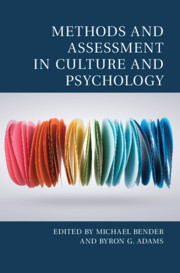Book contents
- Methods and Assessment in Culture and Psychology
- Culture and Psychology
- Methods and Assessment in Culture and Psychology
- Copyright page
- Dedication
- Additional material
- Contents
- Figures
- Tables
- Contributors
- Foreword
- 1 Introduction to Methods and Assessment in Culture and Psychology
- Part 1 Acculturation and Identity
- Part 2 Individual Differences across Cultures
- 6 Broadening the Bases of Methodological Rigor in Cross-Cultural Educational Assessment
- 7 Individuals, Groups, and Classrooms: Conceptual and Methodological Considerations on Studying Approaches to Cultural Diversity in Schools
- 8 Emotion between Universalism and Relativism: Finding a Standard for Comparison in Cross-Cultural Emotion Research
- 9 Culture Is More Than Self-Reported Motives, Beliefs, and Values: Methodological Advancements of Measuring Implicit Motives across Cultural Contexts
- 10 Development of the South African Personality Inventory: A Cross-Cultural Design in a Non-Western Society ‒ Lessons Learned and Generalizability to Other Parts of the World
- 11 Combining Global and Local Approaches in Psycholexical Studies: Glocal Illustrations from Studies on Arabic
- Part 3 Culture and Assessment
- Index
- References
10 - Development of the South African Personality Inventory: A Cross-Cultural Design in a Non-Western Society ‒ Lessons Learned and Generalizability to Other Parts of the World
from Part 2 - Individual Differences across Cultures
Published online by Cambridge University Press: 21 January 2021
- Methods and Assessment in Culture and Psychology
- Culture and Psychology
- Methods and Assessment in Culture and Psychology
- Copyright page
- Dedication
- Additional material
- Contents
- Figures
- Tables
- Contributors
- Foreword
- 1 Introduction to Methods and Assessment in Culture and Psychology
- Part 1 Acculturation and Identity
- Part 2 Individual Differences across Cultures
- 6 Broadening the Bases of Methodological Rigor in Cross-Cultural Educational Assessment
- 7 Individuals, Groups, and Classrooms: Conceptual and Methodological Considerations on Studying Approaches to Cultural Diversity in Schools
- 8 Emotion between Universalism and Relativism: Finding a Standard for Comparison in Cross-Cultural Emotion Research
- 9 Culture Is More Than Self-Reported Motives, Beliefs, and Values: Methodological Advancements of Measuring Implicit Motives across Cultural Contexts
- 10 Development of the South African Personality Inventory: A Cross-Cultural Design in a Non-Western Society ‒ Lessons Learned and Generalizability to Other Parts of the World
- 11 Combining Global and Local Approaches in Psycholexical Studies: Glocal Illustrations from Studies on Arabic
- Part 3 Culture and Assessment
- Index
- References
Summary
The usual operationalization of the psycholexical approach to personality becomes inefficient when dealing with languages with a limited lexicography or languages that are inaccessible to the investigator. These conditions, which probably hold for most of the world’s languages, call for different approaches to uncover the complexities of personality. This chapter describes the mixed-method approach in designing the South African Personality Inventory (SAPI). We describe (1) the dynamics and lessons learned from the extensive qualitative research conducted in 11 languages, (2) the challenges of item development and reduction with a focus on cultural comparability and validity, and (3) the complexities in extracting and validating the SAPI factor structure across language versions. We discuss how the diversification of methods can enrich the understanding of personality in understudied contexts and inform the debate between universal models (with their lure of cross-cultural comparability) and indigenous models (with their claim to ecological validity).
Keywords
- Type
- Chapter
- Information
- Methods and Assessment in Culture and Psychology , pp. 198 - 227Publisher: Cambridge University PressPrint publication year: 2021



